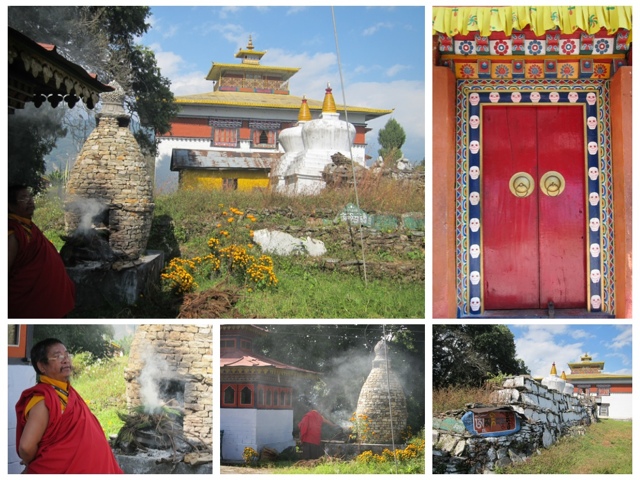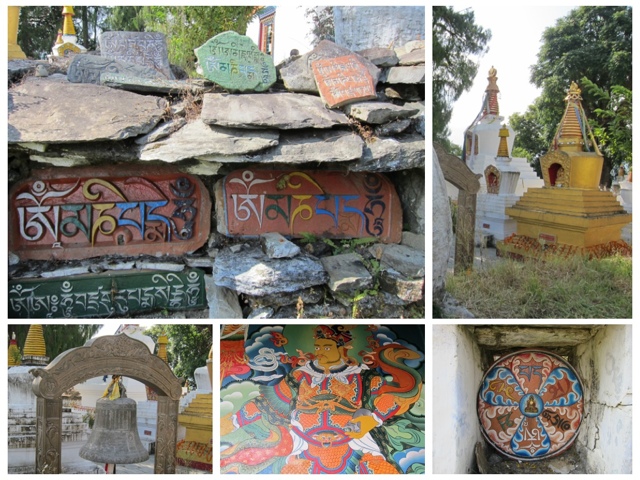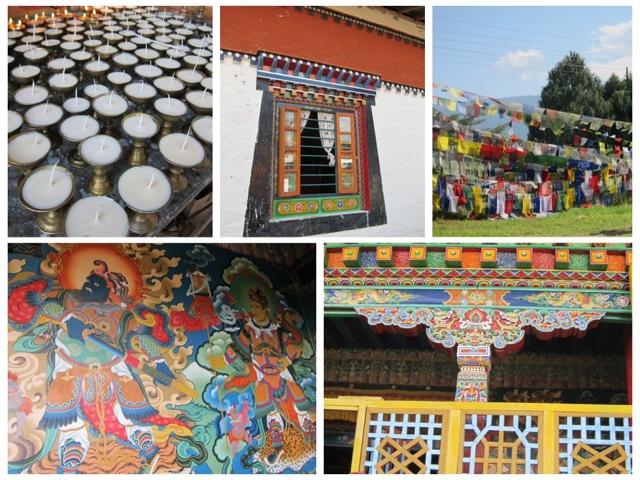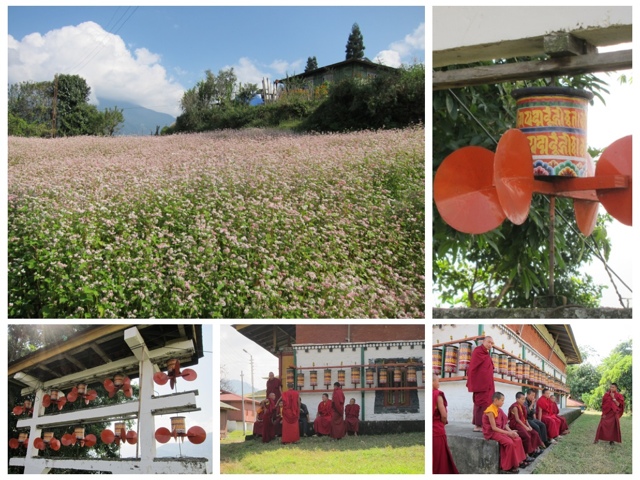From Yangsum Farm to Yuksom, and a visit to Tashiding Monastery, Western Sikkim, Himalayas, India
The path up to the Tashiding Gompa Buddhist monastery is lined with prayer flags.
The steps climb up and up, and a small village sits alongside the path.
We arrived on a day in which monks and Lamas from neighboring temples came over to this large and beautiful temple to celebrate and perform Pujas together.
This celebratory Puja is an annual Buddhist special event, in which temples and devotees celebrate the return of Buddha back to earth from Tushita (heaven).
The Buddha's mother, named Maya Deva, had died before he reached enlightenment.
So.... It is said that after his Enlightenment, the Buddha went into the realm of the unseen where his mother was reborn and he preached before the divine congregation, including his mother, for three months.
It is said that the day he came back to earth was in the ninth month of the Tibetan calendar, which falls on November 6th.
This multi-day puja that started on November 6th, was done to celebrate the Buddha's return from Tushita (heaven).
When we reached the top of the hill, we visited the three grand halls.
Each had beautiful Buddhist murals on the walls and great clay and carved wood statues.
Between the temples spread a vast area filled with old and new stupas.
One of the stupas had a sign saying that just beholding this stupa can help a practitioner along the path....
Those stupas were mostly erected to honor departed holy high Lamas.
The whole area was full of small flat marble and slate stones, each carved and painted with the Mani mantra
I saw a smoke rising up, and noticed that the sound of drums and trumpets was coming from farther down the hill.
It was a Buddhist cremation.
People were gathered there, and the monks were performing the cremation rituals.
In Hindu tradition, the body is cremated while laying down.
In Buddhist cremations, the body is cremated while sitting up.
The firewood is put around the seated body, and the monks perform chants and rituals until there is nothing left.
Every few minutes, while the cremation was going on, the monks burst into chanting and beat the drums and blew the trumpets.
One monk came out with a plate of grains which was put on a long stick with a flat copper plate at the end of it.
An attendant fed the rice or the other grains to the fire, and the chanting and the music quieted down for five more minutes.
I sat on a piece of log and observed the proceedings.
Other people from the village also sat around and observed as well.
You never feel like an intruder in this area.
People are so willing to engage in a conversation and many are so generous with their time.
I almost never encountered a sense of business and lack of patience.
One of the village women was offering to everyone cups of tea from large aluminum tea pots.
There was plenty of food and snacks.... Apparently a cremation funeral is a day long activity.
Back at the temple, we followed a wall of carved stone Mani Mantras, and saw an ascetic old man sitting in a stone hut.
He was the man who carved and painted all those stones, which people pay to get done when one of their loved ones departs this earth.
They put those carved stones around the stupas, to be close to the spirits of the wise and enlightened departed Lamas.
The monk told us that he was 85 years old and that he had come from Tibet.
He had been carving and painting flat pieces of stones since he was a young man.
It was past lunch time, and I felt a bit fatigued and hungry.
I suggested that we stop at one of the shacks that I saw on our way to the monastery.
It had an English sign that said "Hot Bites."
They did not have Momos, which are what passes for fast food in this area, but they did have a delicious bowl of Tibetan Veg Thukpa noodle soup.
We sat in their covered shack, and the curtains were blowing in the wind.
The only place to sit was at the back of the shack, where I saw a bundle of blankets that turned out to be a sweetly sleeping baby.
We sat next to this sleeping baby, who did not wake up by the sounds around her.
Our drive from Yangsum to Yuksum took us on a beautiful mountain road filled with waterfalls which often flood the road, and during the monsoon season, make the road totally impassable.
Our hotel in Yuksom offered great decks overlooking the surrounding mountains and valleys.
Yuksom was the first capital of Sikkim in the 1600's.
The ancient capital has moved two more times since then.
The history of Sikkim says that in the 1300's, three high Lamas from three different regions of Tibet, had a spontaneous vision that they should come to Sikkim.
The Lamas, who did not know that each other, followed their vision and met in the Yuksom area, which became the name of this region.
Yuksom means "The meeting place of the three Lamas."
The three Lamas started teaching Buddhism to the local Lepchas and slowly converted them to Buddhism.
Before this, the Lepchas were animists.
Sikkim was a region of rice growing.
The word 'Sikkim' actually means 'The valley of rice.'
The area has much to see and explore, and it is most famous today for being the starting point of long treks in Sikkim.
The season had already started getting much colder, and I have to admit that I did not envy at all, any of those trekkers who were getting ready for their nine days of trekking.... It is freezing up there.....
But then again.... It is the mystical Himalayas... And the words of Sabkar, the Tibetan yogi whisper in my ears:
"Snow lions do not freeze in the snowy mountains
Vultures do not fall out of the sky
Fish don't drown in the lakes
Meditators do not die of hunger
So cast away all concerns in this life
Give up plans for the future!"
(Shabkar)
The steps climb up and up, and a small village sits alongside the path.
We arrived on a day in which monks and Lamas from neighboring temples came over to this large and beautiful temple to celebrate and perform Pujas together.
This celebratory Puja is an annual Buddhist special event, in which temples and devotees celebrate the return of Buddha back to earth from Tushita (heaven).
The Buddha's mother, named Maya Deva, had died before he reached enlightenment.
So.... It is said that after his Enlightenment, the Buddha went into the realm of the unseen where his mother was reborn and he preached before the divine congregation, including his mother, for three months.
It is said that the day he came back to earth was in the ninth month of the Tibetan calendar, which falls on November 6th.
This multi-day puja that started on November 6th, was done to celebrate the Buddha's return from Tushita (heaven).
When we reached the top of the hill, we visited the three grand halls.
Each had beautiful Buddhist murals on the walls and great clay and carved wood statues.
Between the temples spread a vast area filled with old and new stupas.
One of the stupas had a sign saying that just beholding this stupa can help a practitioner along the path....
Those stupas were mostly erected to honor departed holy high Lamas.
The whole area was full of small flat marble and slate stones, each carved and painted with the Mani mantra
I saw a smoke rising up, and noticed that the sound of drums and trumpets was coming from farther down the hill.
It was a Buddhist cremation.
People were gathered there, and the monks were performing the cremation rituals.
In Hindu tradition, the body is cremated while laying down.
In Buddhist cremations, the body is cremated while sitting up.
The firewood is put around the seated body, and the monks perform chants and rituals until there is nothing left.
Every few minutes, while the cremation was going on, the monks burst into chanting and beat the drums and blew the trumpets.
One monk came out with a plate of grains which was put on a long stick with a flat copper plate at the end of it.
An attendant fed the rice or the other grains to the fire, and the chanting and the music quieted down for five more minutes.
I sat on a piece of log and observed the proceedings.
Other people from the village also sat around and observed as well.
You never feel like an intruder in this area.
People are so willing to engage in a conversation and many are so generous with their time.
I almost never encountered a sense of business and lack of patience.
One of the village women was offering to everyone cups of tea from large aluminum tea pots.
There was plenty of food and snacks.... Apparently a cremation funeral is a day long activity.
Back at the temple, we followed a wall of carved stone Mani Mantras, and saw an ascetic old man sitting in a stone hut.
He was the man who carved and painted all those stones, which people pay to get done when one of their loved ones departs this earth.
They put those carved stones around the stupas, to be close to the spirits of the wise and enlightened departed Lamas.
The monk told us that he was 85 years old and that he had come from Tibet.
He had been carving and painting flat pieces of stones since he was a young man.
It was past lunch time, and I felt a bit fatigued and hungry.
I suggested that we stop at one of the shacks that I saw on our way to the monastery.
It had an English sign that said "Hot Bites."
They did not have Momos, which are what passes for fast food in this area, but they did have a delicious bowl of Tibetan Veg Thukpa noodle soup.
We sat in their covered shack, and the curtains were blowing in the wind.
The only place to sit was at the back of the shack, where I saw a bundle of blankets that turned out to be a sweetly sleeping baby.
We sat next to this sleeping baby, who did not wake up by the sounds around her.
Our drive from Yangsum to Yuksum took us on a beautiful mountain road filled with waterfalls which often flood the road, and during the monsoon season, make the road totally impassable.
Our hotel in Yuksom offered great decks overlooking the surrounding mountains and valleys.
Yuksom was the first capital of Sikkim in the 1600's.
The ancient capital has moved two more times since then.
The history of Sikkim says that in the 1300's, three high Lamas from three different regions of Tibet, had a spontaneous vision that they should come to Sikkim.
The Lamas, who did not know that each other, followed their vision and met in the Yuksom area, which became the name of this region.
Yuksom means "The meeting place of the three Lamas."
The three Lamas started teaching Buddhism to the local Lepchas and slowly converted them to Buddhism.
Before this, the Lepchas were animists.
Sikkim was a region of rice growing.
The word 'Sikkim' actually means 'The valley of rice.'
The area has much to see and explore, and it is most famous today for being the starting point of long treks in Sikkim.
The season had already started getting much colder, and I have to admit that I did not envy at all, any of those trekkers who were getting ready for their nine days of trekking.... It is freezing up there.....
But then again.... It is the mystical Himalayas... And the words of Sabkar, the Tibetan yogi whisper in my ears:
"Snow lions do not freeze in the snowy mountains
Vultures do not fall out of the sky
Fish don't drown in the lakes
Meditators do not die of hunger
So cast away all concerns in this life
Give up plans for the future!"
(Shabkar)






























